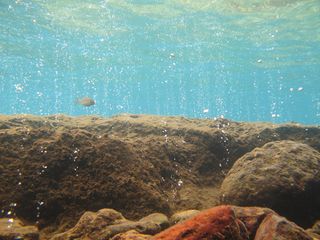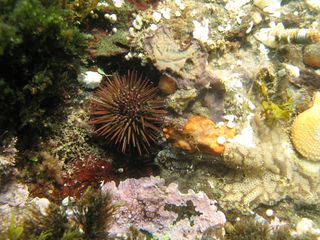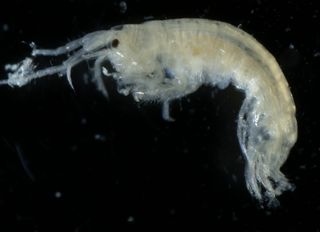
Volcanic Vents Give Sneak Peek of Acidic Ocean

The underwater volcanoes off a tiny Italian island are helping scientists peer into the future of a world altered by increasing amounts of carbon dioxide emitted into the air and absorbed into the oceans.
The waters just off the island of Ischia mirror the projected conditions of the Earth's oceans at the beginning of the next century because the volcanic vents found there infuse the water with large helpings of carbon dioxide, or CO2, which turns seawater acidic.
Research has shown that the growing acidic conditions are harmful to some sea creatures — those that build their protective shells with calcium are increasingly prevented from doing so the more acidic waters become.
The fates of these creatures and the stability of the ocean food chain are a major concern over the next century and beyond because of the carbon dioxide being released into the atmosphere by humans, as the oceans absorb about 30 percent of this carbon dioxide.

"One part of climate change that is indisputable is that CO2 is rising in the atmosphere — it's easy to measure," said Bill Chadwick, an Oregon State University geologist. "And it's indisputable that it is making the oceans more acidic — we can measure it."
Kristy Kroeker, lead author on a recent study published in the Proceedings of the National Academy of Science, used the volcanic vents off Ischia to see just what effects acidic waters had on the makeup of marine life communities.
Natural laboratory
Sign up for the Live Science daily newsletter now
Get the world’s most fascinating discoveries delivered straight to your inbox.
Undersea volcanoes around the world release CO2, Chadwick, who was not a part of Kroeker's study, said.
"It's a little bit of a natural laboratory for the effects of ocean acidification from atmospheric CO2 — the CO2 that we're pumping out from burning hydrocarbons," Chadwick told OurAmazingPlanet.
Most undersea volcanoesspew out superheated water and sulfur, along with carbon dioxide — this mixture creates some extreme living conditions and extreme creatures. In contrast, Ischia's volcanic vents are relatively gentle.
"This releases primarily carbon dioxide. There's no temperature change, and no sulfur," Kroeker said, "so you can look at the effects of the carbon dioxide itself."
Kroeker compared being in the waters around these vents to "swimming though a Jacuzzi or a glass of champagne. There are little bubbles coming out of the ground all around you."
Just about 100 yards from shore, and in waters 6 to 15 feet deep (2 and 3 meters), the volcanic vents create an underwater landscape that transitions from normal pH (8.1) to pH levels projected to arrive by the year 2100 (7.8), to highly acidic conditions (in the highs 6s and low 7s).
Although there is plenty of research on the nasty toll acidic water takes on shell-building animals, Kroeker's research is some of the first to examine how increasingly acidic water affects underwater communities as a whole. [Earth in the Balance: 7 Crucial Tipping Points]
As expected, Kroeker found that as pH decreased (and water got more acidic), the local populations changed. The more acidic the waters, the less variety seen in communities of sea creatures.

"Even though there were the same number of animals in these zones, the animals were very different," Kroeker said. Tiny crustaceans and brown and green algae thrived in the most acidic environments, while larger creatures were absent. "You're losing these bigger organisms that are the size of a peanut M&M and replacing them with organisms the size of a rice grain," Kroeker said.
Although scientists don't expect the world's oceans will ever likely be as acidic as the most extreme environments she studied, Kroeker said the research shows the spectrum of biological responses that acidification triggers.
"You can see it," she said. Vibrant pink and orange algae, bright sea urchins and crawling snails in normal waters were replaced by fewer creatures in the 7.8 pH zone, and, in the extreme acid waters, by a seemingly barren landscape of browns and greens.
However, Kroeker did find that some snails — shell-building creatures — were living in the 7.8 acidity zone.
"It is encouraging," she said. "It shows there is some ability for some of these calcified organisms to survive, but it brings up a lot of questions about why they are able to survive," Kroeker said.
Kroeker said that although her work demonstrated some of the changes wrought by ocean acidification on small creatures, there's reason to think those changes could have far-reaching effects up the food chain.
It's not just about snails or sea urchins or tiny crustaceans, she said, it's about the way changes in their numbers could affect the larger creatures that eat them — including humans.
- The World's Biggest Oceans and Seas
- Infographic: Tallest Mountain to Deepest Ocean Trench
- Video: New Vent Opens at Axial Underwater Volcano
Follow OurAmazingPlanet for the latest in Earth science and exploration news on Twitter @OAPlanet and on Facebook.
Most Popular

